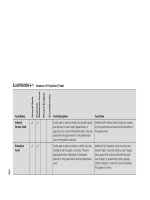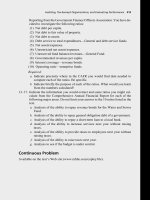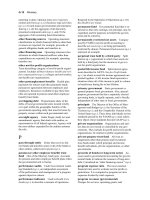essentials of ta for fin mkts - chen 2010
Bạn đang xem bản rút gọn của tài liệu. Xem và tải ngay bản đầy đủ của tài liệu tại đây (7.07 MB, 304 trang )
E1FFIRS 02/20/2010 12:40:7 Page 6
E1FFIRS 02/20/2010 12:40:6 Page 1
ESSENTIALS
of Technical
Analysis for
Financial Markets
E1FFIRS 02/20/2010 12:40:6 Page 2
ESSENTIALS SERIES
The Essentials Series was created for busy business advisory and corporate professio-
nals. The books in this series were designed so that these busy professionals can
quickly acquire knowledge and skills in core business areas.
Each book provides need-to-have fundamentals for those professionals who
must:
Get up to speed quickly, because they have been promoted to a new position or
have broadened their responsibility scope
Manage a new functional area
Brush up on new developments in their area of responsibility
Add more value to their company or clients
Other books in this series include:
Essentials of Accounts Payable, Mary S. Schaeffer
Essentials of Balanced Scorecard, Mohan Nair
Essentials of Business Ethics, Denis Collins
Essentials of Business Process Outsourcing, Thomas N. Duening and Rick L. Click
Essentials of Capacity Management, Reginald Tomas Yu-Lee
Essentials of Cash Flow, H.A. Schaeffer, Jr.
Essentials of Corporate Fraud, Tracy L. Coenen
Essentials of Corporate Governance, Sanjay Anand
Essentials of Corporate Performance Measurement, George T. Friedlob, Lydia L.F. Schleifer,
and Franklin J. Plewa, Jr.
Essentials of Cost Management, Joe and Cather ine Stenzel
Essentials of Credit, Collections, and Accounts Receivable, Mary S. Schaeffer
Essentials of CRM: A Guide to Customer Relationship Management, Bryan Bergeron
Essentials of Enterprise Compliance, Susan D. Conway and Mara E. Conway
Essentials of Financial Analysis, George T. Friedlob and Lydia L. F. Schleifer
Essentials of Financial Risk Management, Karen A. Horcher
Essentials of Foreign Exchange Trading, James Chen
Essentials of Licensing Intellectual Property, Paul J. Lerner and Alexander I. Poltorak
Essentials of Knowledge Management, Bryan Bergeron
Essentials of Managing Corporate Cash, Michele Allman-Ward and James Sagner
Essentials of Managing Treasury, Karen A. Horcher
Essentials of Patents, Andy Gibbs and Bob DeMatteis
Essentials of Payroll Management and Accounting, Steven M. Bragg
Essentials of Sarbanes-Oxley, Sanjay Anand
Essentials of Shared Services, Bryan Bergeron
Essentials of Supply Chain Management, Michael Hugos
Essentials of Trademarks and Unfair Competition, Dana Shilling
Essentials of XBRL, Bryan Bergeron
For more information on any of the above titles, please visit www.wiley.com.
E1FFIRS 02/20/2010 12:40:7 Page 3
ESSENTIALS
of Technical
Analysis for
Financial Markets
James Chen
John Wiley & Sons, Inc.
E1FFIRS 02/20/2010 12:40:7 Page 4
Copyright # 2010 by James Chen. All rights reserved.
Published by John Wiley & Sons, Inc., Hoboken, New Jersey.
Published simultaneously in Canada.
No part of this publication may be reproduced, stored in a retrieval system, or
transmitted in any form or by any means, electronic, mechanical, photocopying,
recording, scanning, or otherwise, except as permitted under Section 107 or 108 of
the 1976 United States Copyright Act, without either the prior written permission
of the Publisher, or authorization through payment of the appropriate per-copy fee
to the Copyright Clearance Center, Inc., 222 Rosewood Drive, Danvers, MA
01923, (978) 750-8400, fax (978) 646-8600, or on the web at www.copyright.com.
Requests to the Publisher for permission should be addressed to the Permissions
Department, John Wiley & Sons, Inc., 111 River Street, Hoboken, NJ 07030, (201)
748-6011, fax (201) 748-6008, or online at />Limit of Liability/Disclaimer of Warranty: While the publisher and author have
used their best efforts in preparing this book, they make no representations or
warranties with respect to the accuracy or completeness of the contents of this
book and specifically disclaim any implied warrant ies of merchantability or fitness
for a particular purpose. No warranty may be created or extended by sales
representatives or wr itten sales materials. The advice and strategies contained
herein may not be suitable for your situation. You should consult with a
professional where appropriate. Neither the publisher nor author shall be liable for
any loss of profit or any other commercial damages, including but not limited to
special, incidental, consequential, or other damages.
For general information on our other products and services or for technical support,
please contact our Customer Care Department within the United States at (800)
762-2974, outside the United States at (317) 572-3993 or fax (317) 572-4002.
Wiley also publishes its books in a variety of electronic formats. Some content that
appears in print may not be available in electronic books. For more information
about Wiley products, visit our web site at
www.wiley.com.
Librar
y of Congre
ss Cataloging-in-Publication Data:
Chen, James, 1971-
Essentials of technical analysis for financial markets / James Chen.
p. cm.—(Essentials series)
Includes index.
ISBN 978-0-470-53729-9 (pbk.)
1. Investment analysis. I. Title.
HG4529.C456 2010
332.63
0
2042—dc22 2009051054
ISBN-13 978-0-470-53729-9
Printed in the United States of America
10987654321
E1FFIRS 02/20/2010 12:40:7 Page 5
To my parents, my wife,
my children, and technical
analysts everywhere
E1FFIRS 02/20/2010 12:40:7 Page 6
E1FTOC 02/26/2010 15:47:58 Page 7
Contents
Preface xiii
Acknowledgments xvii
1 Introduction to Technical Analysis:
Pursuing Profit in the Financial Markets 1
What Is Technical Analysis? 2
Technical versus Fundamental 2
Methods 5
What to Expect 5
Summary 9
2 The Story of Technical Analysis:
From the Japanese Rice Markets to
Dow Theory to Automated Trading 11
The Beginning: Japanese Rice Markets 12
Dow Theory 14
Charting 17
Elliott Wave 18
W. D. Gann 20
Indicators 20
vii
E1FTOC 02/26/2010 15:47:58 Page 8
Trend Followers 22
Market Technicians Association 23
Technical Analysis Today 23
Summary 24
3 The Power of Technical Analysis:
Principles of Price Action 27
Introduction to Price Action Concepts 28
Components of Price Action 29
Summary 32
4 The Basics of Technical Analysis:
Bars, Candlesticks, Lines,
and Point and Figure 33
Bars and Candlesticks 34
Line Charts 37
Point-and-Figure Charts 38
Summary 40
5 The Heart of Technical Analysis:
Uptrends and Downtrends 41
Introduction to Trend 42
Effect of Time Frames on Trend Determination 50
Parallel Trend Channels 52
Trend Lines 54
Summary 55
6 The Soul of Technical Analysis:
Support and Resistance 57
Introduction to Support and Resistance 58
Contents
viii
E1FTOC 02/26/2010 15:47:58 Page 9
Support Becomes Resistance Becomes Support 60
Summary 64
7 Primary Drawing Tools: Trend Lines, Trend Channels,
and Horizontal Support and Resistance 65
Introduction to Drawing Tools 66
Static Support and Resistance 67
Dynamic Support and Resistance 72
Horizontal Support and Resistance Lines 78
Trend Lines 81
Parallel Trend Channels 87
Summary 89
8 Chart Patterns: Bar Shapes and Candlestick
Formations 91
Introduction to Chart Patterns 91
Continuation Bar Patterns 93
Reversal Bar Patterns 102
Gaps 106
Candlestick Patterns 110
Single-Candle Patterns 111
Multiple-Candle Patterns 116
Summary 118
9 The World of Moving Averages 119
Introduction to Moving Averages 119
Moving Average Crossovers 123
Moving Averages as Support and Resistance 131
Summary 134
Contents
ix
E1FTOC 02/26/2010 15:47:58 Page 10
10 Key Technical Indicators and Oscillators 135
Introduction to Indicators and Oscillators 135
Key Indicators 139
Key Oscillators 148
Summary 159
11 Fibonacci and Elliott Wave 161
Fibonacci Theory and Methods 161
Elliott Wave Theory 170
Summary 175
12 Point-and-Figure Charting 177
Introduction to Point and Figure 177
Point-and-Figure Patterns 181
Point-and-Figure Price Targets 188
Summary 190
13 Volume 193
Introduction to Volume 193
On-Balance Volume 196
Tick Volume 198
Summary 199
14 Technical Trading Strategies: Practical
Applications 201
Introduction to Technical Trading Strategies 202
Moving Average Crossovers 203
Breakout Trading 212
Trend Trading 224
Contents
x
E1FTOC 02/26/2010 15:47:58 Page 11
Range Trading 238
Price-Oscillator Divergences 244
Oscillator Trading 249
Fibonacci Trading 254
Positive Expectancy 256
Summary 258
15 Risk Control and Money Management 261
Introduction to Risk Control and
Money Management 262
Stop-Losses 263
Reward:Risk Ratio 266
Maximum Allowable Loss 269
Multiple Fractional Positions 271
Diversification 273
Summary 273
Index 277
Contents
xi
E1FTOC 02/26/2010 15:47:58 Page 12
E1FPREF 02/24/2010 16:25:24 Page 13
Preface
T
he practice of technical analysis has g rown at a remarkably
rapid pace in the last few decades. Traders, investors, and ana-
lysts involved in all of the var ious financial markets have
increasingly turned to the principles of technical analysis both to
interpret as well as to act on market price behavior. These practi-
tioners recognize that technical analysis provides a concrete, logical,
and effective approach to tackling any major financial market.
In addition, the development of new methods a nd techniques
within the realm of technical analysis has been equally rapid.
Whether it is the latest and greatest technical indicator or a fresh and
innovative way to denote support and resistance, technical analysis
has generally progressed in a swift, continuous manner since its
inception. Many of these new developments have contributed subs-
tantially to the further evolution of the field.
Consequently, innumerable specialties and subspecialties have de-
veloped within the discipline of technical analysis. In my years as an
analyst and trader, however, I have deliberately refrained from having
my primary focus ‘‘progress’’ onto excessively complex or esoteric
concepts within the field. As a result, many have asked me why I
xiii
E1FPREF 02/24/2010 16:25:24 Page 14
keep my analysis and trading so simple. My answer is always the same:
Simple, at least in the arenas of technical analysis and technical trad-
ing, works quite well. Therefore, I have consistently prefer red to
focus all concentration on the essentials, as opposed to diluting atten-
tion on the countless areas of technical analysis that can possibly be
focused on.
A quick look at any one of my daily or intraday analysis charts
will illustrate my general approach. I like to draw lines, and lots of
them—shor t lines, long lines, horizontal lines, angled lines, line
shapes, and everything in between. I tend to keep the mechanical
indicators on my charts to a minimum, although anything that helps
me better identify the trend (like moving averages) and the key sup-
port/resistance levels within a g iven market is a welcomed element in
my trading arsenal.
In light of the simplicity of this approach, if I was asked to sum-
marize the essence of technical analysis and technical trading in a
concise, working description, it would probably be this: the study of
how mass market behavior affects the manner in which market prices
move in relation to the trend and support/resistance.
When all of the layers are peeled away, these are essentially the
ele ments that remain. In fact, the majority of mainstream technical
analysis t ools and studies ultimately just help define or act on the
trend, support/resistance, or a combination of both.
To clarify further, the concept of trend can refer to a directional
price move, a reversal of the prior directional price move, or a lack of
direction in the market altogether. The concept of support/resistance
can refer to static price levels (unchanging levels at which a market
Preface
xiv
E1FPREF 02/24/2010 16:25:24 Page 15
may react in a significant manner) or to dynamically changing price
levels (as in an ascending or descend ing trend line).
Staying on the theme of keeping it simple, a lthough different
technical analysts gravitate toward different techniques and methods,
I would strongly stress the fact that the most successful practitioners
tend to concentrate primarily on only one or a few aspects of the
discipline. If one is able to know a particular method inside and
out—whether it is drawing trend lines, using the relative strength
index, counting Elliott Waves, trading Fibonacci retracements, iden-
tifying reversal patterns, or any one of the countless other technical
approaches to the financial markets—the path to trading success will
likely be much smoother than if one attempts to dabble in a little bit
of ever ything. Again, keeping it simple by mastering one or a few
essential aspects of technical analysis is much preferred over diluting
attention in all different directions.
With that having been said, this book should act as your straight-
fo rward guide to the wealth of essential method s and approaches
that are available within the field of financial technical analysis.
There is much to choose from within these pages, but once a focus is
established, the rest is simply a matter of exhaustive further study,
experimentation, and experience.
Good luck and good trading.
James Chen
Preface
xv
E1FPREF 02/24/2010 16:25:24 Page 16
E1FLAST 02/06/2010 10:8:0 Page 17
Acknowledgments
F
or their tremendous support and understanding during the
time I was writing this book, as well as in all other aspects of
life, I would like to thank my parents, Shou Lien and Hsiao-
wen; my brother and sister, Jack and Julie; my wife, Dongping; my
sons, Tommy and Kevin; and my newborn daughter, Emily.
Additionally, I would like to acknowledge all of the tireless hard
work and support from the wonderful editors at John Wiley & Sons,
including Tim Burgard and S tacey Rivera, who also publishe d my
previous book, Essentials of Foreign Exchange Trading (2009).
Sincere gratitude also goes out to these trading industry lumina-
ries for generously contributing their knowledge and expertise in the
form of insightful book passages: Robert Prechter, Jr.; Steve Nison;
Alexander Elder; and Michael Covel.
Finally, I would like to give a big thanks to my many colleagues at
FX Solutions who have consistently shown a great deal of interest
and encouragement during the course of my writing this book.
xvii
E1FLAST 02/06/2010 10:8:1 Page 18
E1C01_1 02/20/2010 1
CHAPTER 1
Introduction to
Technical Analysis
Pursuing Profit in
the Financial
Markets
After reading this chapter, you will be able to:
Understand the general concept of technical analysis.
Discern the basic differences between technical analysis
and fundamental analysis.
Recognize some of the key tools and methods of technical
analysis.
Know what concepts will be discussed throughout the rest
of this book.
1
E1C01_1 02/20/2010 2
What Is Technical Analysis?
Technical analysis is the study of how past and present price action in
a given financial market may help determine its future direction. At
the same time, however, technical analysis should not be considered a
crystal ball. Rather, the skills of a technical analyst are used primarily
to help determine the highest-probability reactions to past and
cur rent price movement, as well as likely future price movement.
Therefore, technical analysis is less about actually predicting the
future and more about finding high-probability potential opportuni-
ties to trade in the financial markets.
The primary tool used by technical analysts is the ubiquitous
price chart, which generally plots prices over a given period of time.
The var ious major chart types are discussed i n detail in Chapter 4,
which covers the basics of technical analysis. Different analysts/
traders may choose to use different types of charts at different
times, whether it is a line chart, a bar chart, a candlestick char t, a
point-and-figure chart, or any of a number of other chart types.
Technical versus Fundamental
When many people in the financial world refer to technical analysis,
it is often in direct contrast to the other major school of market anal-
ysis, fundamental analysis. The contrast between the two is clear and
distinct.
Fundamental analysis focuses on what the underlying reasons
may be for market movement. In the stock market, this would consist
of news and financial information (e.g., earnings) that are directly as-
sociated with a particular publicly traded company. In the futures
2
Introduction to Technical Analysis
E1C01_1 02/20/2010 3
market, it would consist of substantive market information regarding
a specific commodity (e.g., wheat or oil) or financial market/index
(e.g., S&P 500). In the foreign exchange, or currency, market, funda-
mental analysis would be primarily concerned with inter national
economies, central bank policy, interest rates, and inflation.
Fundamental analysis stands in stark contrast to the world of tech-
nical analysis. Instead of concerning itself with the underlying reasons
for price movement, technical analysis focuses on the price movement
itself and how mass human behavior is manifested in price action.
Technical analysts believe that all fundamental information and eco-
nomic factors that can cause price movement are already reflected in
price action. Therefore, technical analy sis purists generally avoid
looking at earnings or crop reports or international economic condi-
tions. Instead, the two primary tools of price and volume as depicted
on a fin ancial chart are sufficient for most an alysts of the technical
persuasion. Of these two tools, price is universally more important.
Here is another way to describe the distinction between funda-
mental analysis and technical analysis: While fundamental analysis m ay
concern itself with the myriad reasons ‘‘why’’ price moves, technical
analysis is single-mindedly focused on ‘‘how’’ price mo ves and the w ay
in which that might affect future price movement. Technical analysis
consists of a broad methodology through which traders can identify
trading opportunities and make all of their most important trading
decisions. This includes trade entries, trade exits, stop-loss placement,
pr ofit target placement, trade sizing, risk management, and mor e.
While some trade rs and investors are strict adherents to either
fundamental analysis or technical analysis, and completely exclude
consideration of the other, many use a combination of both.
3
Technical versus Fundamental
E1C01_1 02/20/2010 4
EXECUTIVE INSIGHT
Robert Prechter, Jr., CMT
In a written interview with the author, Robert Prechter, Jr., pub-
lisher of The Elliott Wave Theorist since 1979 and founder/presi-
dent of Elliott Wave Internationa l (elliottwave.com), discu sses
being a pure technician. Legendary for his market timing and
trading acumen utilizing Elliott Wave principles, Prech ter has
won numerous major accolades from the media and financia l
community over an illustrious, decades-long career. He has auth-
ored many books, several of which were instrumental in bringing
Ralph Nelson Elliott’s groundbreaking Elliott Wave Principle
into the forefront of financial market analysis. More about Robert
Prechter, Jr., and his considerable contributions to the develop-
ment of technical analysis can be found in Chapter 2.
Prechter states:
Most analysts are not technicians. But it is also true that most
self-described technicians are not pure technicians. They talk
about Federal Reserve policy, political action, economic news
and other such events as causal to the market’s movement. If
such events are causal, then technical indicators would not be
potent, because randomly occurring outside events would be
creating the supposed patterns, making them spurious. Any
new event could make the market go contrary to what a pattern
or indicator suggested. To be a hybrid analyst is to be theoreti-
cally inco nsistent. Either outside events move the market or
market behavior is patterned. One cannot have it both ways.
A pure technician is someone wh o believes that the stock market’s
causality derives from unchanging aspects of human behavior.
Only if this is true can a head-and-shoulders pattern, a trend line, or
a wave form be reliable. Otherwise such things are simply artifacts
of random movement. True t echnicians are those who rely solely
on technical indicators and m odels such as price trends, cycles,
volume patterns, momentum readings, sentiment indicators,
Elliott Waves, Edwards and Magee patterns, and Dow theory.
4
Introduction to Technical Analysis
E1C01_1 02/20/2010 5
Methods
The methods of utilizing technical analysis are many and varied.
They include such ubiquitous concepts as head and shoulders, sup-
por t and resistance, trends, moving averages, and double-tops. But
they also include concepts that are less popularly known, such as
linear regression, bullish engulfing patterns, Elliott Wave, and point-
and-figure chart s. All o f these elements of technical analysis, and
much more, are discussed in the pages of this book.
The main focus of this book is to provide the essential knowledge
about te chnical an alysis that is necessary to begin serious analysis of
any major fin ancial market. With that goal , this book outlines and
describes the prim ary tools used by technical analysts and traders.
Of cou rse, technical analysis is a huge subject that is growing every
day, and no book could ever hope to cover all of the information
within the field adequately. Therefore, this book provides substantial
coverage of the essentials, as the title suggests, while necessarily omit-
ting some of the more esoteric concepts in the field.
What to Expect
After this introduction, Chapter 2 begins with a concise history of
the most pivotal events in the development of technical analysis—
Fundamentalists look for outside causes and try to predict
them, reasoning from those predictions to market predictions.
Technicians study patterns relating to market behavior and
make decisions on that basis alone. Fund amentalists study
everything but the behavior of the market. Technicians study
only the behavior of the market.
5
What to Expect









